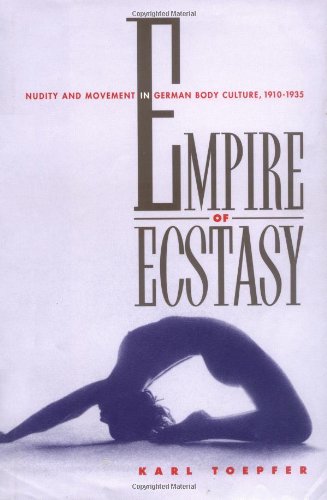Karl Toepfer: Empire of Ecstasy: Nudity and Movement in German Body Culture, 1910-1935 (1997)
Filed under book | Tags: · 1910s, 1920s, 1930s, avant-garde, ballet, bauhaus, body, dance, expressionism, germany, photography, theatre, weimar republic

Empire of Ecstasy offers an interpretation of the explosion of German body culture between the two wars—nudism and nude dancing, gymnastics and dance training, dance photography and criticism, and diverse genres of performance from solo dancing to mass movement choirs. Karl Toepfer presents this dynamic subject as a vital and historically unique construction of “modern identity.”
The modern body, radiating freedom and power, appeared to Weimar artists and intelligentsia to be the source of a transgressive energy, as well as the sign and manifestation of powerful, mysterious “inner” conditions. Toepfer shows how this view of the modern body sought to extend the aesthetic experience beyond the boundaries imposed by rationalized life and to transcend these limits in search of ecstasy. With the help of much unpublished or long-forgotten archival material (including many little-known photographs), he investigates the process of constructing an “empire” of appropriative impulses toward ecstasy.
Toepfer presents the work of such well-known figures as Rudolf Laban, Mary Wigman, and Oskar Schlemmer, along with less-known but equally fascinating body culture practitioners. His book is certain to become required reading for historians of dance, body culture, and modernism.
Publisher University of California Press, 1997
ISBN 0520918274, 9780520918276
422 pages
PDF’d HTML, HTML (from the publisher)
See also Mel Gordon, Voluptuous Panic: The Erotic World of Weimar Berlin, 2000–.
Comment (0)Richard King (ed.): Art in Turmoil: The Chinese Cultural Revolution, 1966-76 (2010)
Filed under book | Tags: · 1960s, 1970s, art, art history, ballet, china, cultural revolution, opera, painting, politics, sculpture

The Cultural Revolution was a massive social and political upheaval resulting from a battle for supremacy within the ruling Chinese Communist Party, set in motion by the party’s chairman Mao Zedong. It was also a time of both brutal iconoclasm and radical experimentation in the arts, the effects of which still resonate today.
Forty years after the Cultural Revolution, Art in Turmoil revisits the visual and performing arts of the period — the paintings, propaganda posters, political cartoons, sculpture, folk arts, private sketchbooks, opera, and ballet. Probing deeply, it examines what these vibrant, militant, often gaudy images meant to artists, their patrons, and their audiences at the time, and what they mean now, both in their original forms and as revolutionary icons reworked for a new market-oriented age.
Chapters by scholars of Chinese history and art and by artists whose careers were shaped by the Cultural Revolution decode the rhetoric of China’s turbulent decade. The many illustrations in the book, some familiar and some never seen before, also offer new insights into works that have transcended their times.
Edited with Ralph Croizier, Shengtian Zheng, and Scott Watson
Publisher UBC Press, Vancouver/Toronto, 2010
Contemporary Chinese Studies series
ISBN 0774815426, 9780774815420
282 pages
review (Stefan R. Landsberger, The China Beat)
Comment (0)
